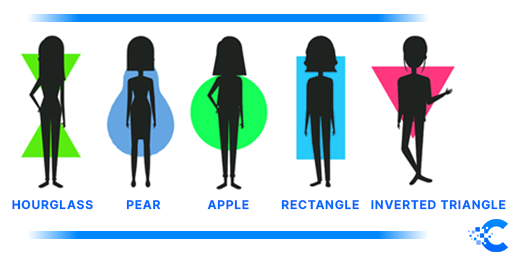Do you want to know what body type your bodysuits are? You can find out very quickly by calculating the waist-to-hip ratio. It is beneficial in assessing the risk associated with weight, heart disease, hypertension, diabetes, and the prevention of obesity. The results obtained by performing these calculations help you to detect possible health risks in time, and at the same time, provide a solution for maintaining the perfect condition of your body. Learn more about what it means and how the waist-to-hip ratio is measured below.
What is a waist-hip ratio?
The ratio of waist to hips is a numerical value with the help of which we can determine whether we are threatened by obesity or some other danger to our health by paying attention to body weight. Unlike the known body mass index (BMI), which uses the ratio of weight to height for the calculation, this indicator considers the ratio of waist circumference to hip circumference. You can also use WHR to determine how much fat has accumulated on your hips, waist, or buttocks.
Why is the waist-hip ratio important?
The importance of this indicator lies in the fact that with the help of this calculation, we can get a better insight into the health status of the respondents and the potential risks of developing severe health conditions. Many studies and analyzes show that people whose body shape is apple-shaped (more pronounced waist circumference) are more likely to face more severe health risks than those whose body shape is pear-shaped (with attention to the larger hip circumference). Another importance and advantage of using this indicator are in the prevention and early learning about the state of obesity of the respondents.
How to measure waist and hips?
The process of calculating the WHR indicator can be done by professional medical staff, and you can do it at home in just a few steps:
- First, you need to measure the waist ratio. Use a measuring tape to place around the broadest part of the abdomen. After proper placement, you need to inhale and complete the measurement after exhaling.
- The next step involves measuring the hips. Stand in a position where your legs are straight, and use a measuring tape to cover the widest part of your hips and buttocks.
- The final step involves a simple mathematical operation of dividing the amount obtained after measuring the waist with the amount received after measuring the hips.
The correct way to measure the WHR indicator is to take off all unnecessary clothes that can leave the impression of a larger volume around your belly.
What does waist to hip ratio calculator do?
To make it easier to calculate this indicator, we can use a waist-to-hip ratio calculator. He works on the principle that we enter the data at the intended place for the hips and the ratio of the waist, and we divide these two amounts and get the ratio.
Waist to hip ratio – example
To give you an idea of how the waist-to-hip ratio calculator works, let’s take a simple example. We will imagine one respondent, a female person named Alex. After the measurement, the waist circumference is 35 inches, and the hips are 40 inches. Based on these data, the WHR indicator for Alex is:
\frac{W}{H}=WHR
\frac{35}{45}=0.875 \; inches
\frac{88.9}{101.6}=0.875 \;cm
What’s the normal waist to hip ratio?
According to research and analysis by health organizations, if the amount of WHR indicators is higher than 1.0, it indicates a higher risk of developing certain severe health conditions. For the female part of the population, the normal WHR indicator should be below 0.85, while for the male part of the population below 0.90.

What’s the perfect waist to hip ratio?
If we want to answer the question of the “perfect” ratio of waist and hips, it depends on whether it is the female part of the population or the male part. When it comes to women, the ideal ratio ranges from 0.67 to 0.80. For a more detailed description, for a waist circumference, the amount of WHR between 24 and 31 inches would be ideal, and for a hip circumference between 36 and 40 inches. For the male population, the perfect waist-to-hip ratio ranges from 1.0 to 0.99.
FAQ
1. Are there limitations to the waist-to-hip ratio?
In addition, disadvantages have been recorded, such as the ease of making errors in the calculation because it is necessary to make separate measurements for the waist and hips. Also, difficulties can especially arise when accurately calculating the circumference of your hips.
2. What is considered an “hourglass” body shape?
The term “hourglass” is most commonly used when the waist-to-hip ratio, and chest-to-hip ratio, are between 0.6 and 0.8, where the most ideal is one equal to 0.7. The moment these two ratios reach the same amount – then your body has the shape of an “hourglass.”
Do you want to know what body type your bodysuits are? You can find out very quickly by calculating the waist-to-hip ratio. It is beneficial in assessing the risk associated with weight, heart disease, hypertension, diabetes, and the prevention of obesity. The results obtained by performing these calculations help you to detect possible health risks in time, and at the same time, provide a solution for maintaining the perfect condition of your body. Learn more about what it means and how the waist-to-hip ratio is measured below.

